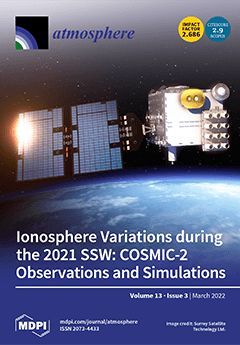This work was conducted to focus on pollutant transmission between Poland and Czechia at the most polluted area in the Czech Republic, the Moravian Silesian region. Instrumental neutron activation analysis (INAA) and multivariate statistical analyses were used to determine the mass fractions of inorganic air pollutants accumulated on filters. Particle matters of sizes smaller than 10 µm (PM
10) were collected using a high-volume sampler (SAM Hi 30 AUTO WIND). Pollutants PM
10 were collected on Whatman QM-A Quartz Microfiber Filters of 150 mm in diameter based on various wind conditions. These filters were irradiated by neutron flux at the experimental reactor IBR-2 at the Joint Institute of Nuclear Research in Dubna, RF. Irradiated samples were measured by gamma spectrometry techniques using HPGe detectors. In total, results are shown for 49 samples (from March to July 2021) and five field blank filters. The mass fractions of 24 elements (Sc, Cr, Fe, Ni, Co, Zn, Se, As, Br, Rb, Mo, Sb, Ba, Cs, La, Ce, Sm, Eu, Tb, Yb, Hf, Au, Th, and U) were determined. The sources of pollution were specified using correlation and exploratory factor analyses and including meteorological conditions. A strong positive correlation was shown between the elements Cr, As, Br, Co, Fe, Sc, Se, Sm, Th, La, and Ce. Elemental exposure to PM
10 can be divided based on the factor loadings of common chemical components into three main pollution sources. According to the wind rose, the pollution came from the southeast/west direction; therefore, we can assume that the pollution most likely originated from the metallurgic complex (steel and iron production in the southeast, and a coking plant, metal foundry, and generation plant in the west).
Full article





